Anyone who is involved with the hunting industry will agree that the fastest growing segment of the outdoor industry today is the exploding crossbow market. With each passing year, more and more companies are jumping into the crossbow pool for an exciting and refreshing dip and a chance to expand their market share by introducing their own version of the “Hottest Crossbow on the Market.”
With so many companies becoming involved in the revolution and new crossbows being introduced to the market in all shapes, sizes and configurations, what is one to do or look for when purchasing his or her very first crossbow? And perhaps an even more important question, which crossbow and which options are the best for you and your hunting needs.
Crossbow Configurations:
All crossbows are similar in the sense that they each have a stock and a bow that fit together to form the “crossbow.” The major differences manifest themselves in the style of bow that is attached to the stock, which currently come in three designs: Recurve, Compound, and Reverse Draw.
Recurve Crossbows have simple recurve limbs exactly like those on a vertical recurve bow, only shorter. This is the simplest version in the crossbow family. The advantage is the simplicity of design lending itself to a bow that is usually quieter when shot and with a lighter, overall weight making it less of a load.
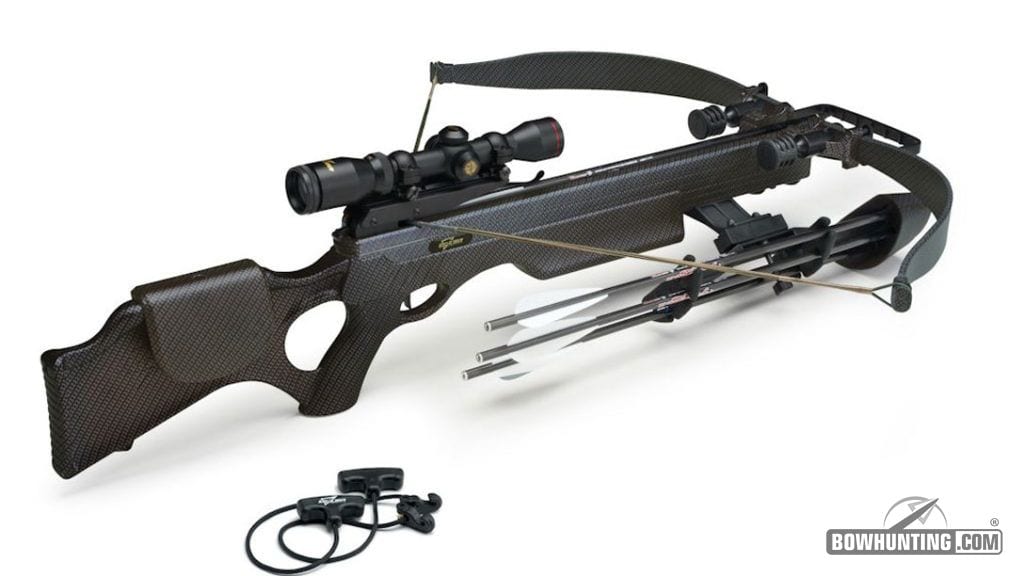
Typical Recurve Crossbow
The disadvantage is the greater width of the bow, which makes it more difficult to handle in dense cover. However, with the latest models, that problem is being overcome by using shorter limbs, shorter power strokes and increased draw weights. The most common service problem with a recurve crossbow is a broken string which happens seldom, provided you regularly service the one you have with string wax and rail lube. The enchanting thing about a recurve crossbow is that you can easily replace the string yourself, right on the scene, provided you have the foresight to pack an extra one in your fanny-pack. The simplicity of a recurve allows you to easily maintain and repair them yourself.
Compound crossbows are more complicated and function with a variety of systems consisting of cables and
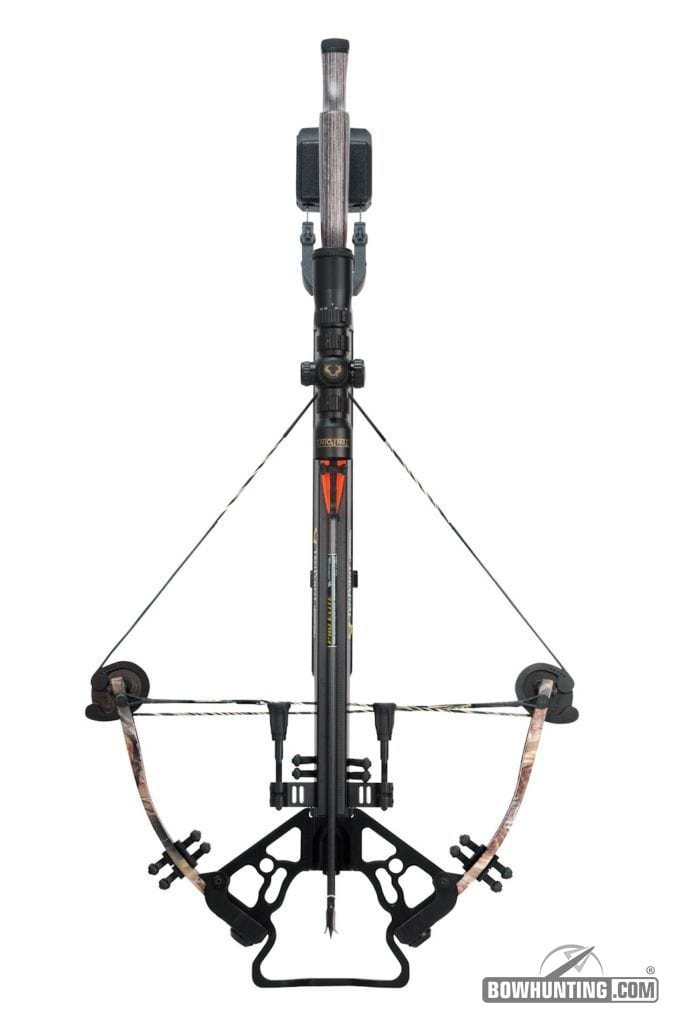
A compound crossbow at full draw.
pulleys just like their vertical compound cousins. The advantages are narrower designs, and in most cases, an advantage in arrow speed. The compound crossbow can be built narrower and longer providing a longer power stroke which increases both speed and kinetic energy. However they may be somewhat heavier and louder when fired because of the extra hardware in their design.
Unless one is an experienced crossbower, a broken string or cables means that the bow will have to be brought back to the shop for repair or sent back to the company to be fixed. This type of bow is more likely to blowup if it is dry-fired or used erroneously. It is the least forgiving of all in the crossbow family.
The Reverse-Draw is the newest member on the crossbow roster. It uses a design that turns the open side of the bow towards the front and uses pulleys, cams and cables similar to those that power the compound bows. This configuration is amazing its users by producing very fast speeds using much lower draw weights because of its radical design.
The Reverse-Draw crossbows are just as quiet as a recurve, but just as heavy and complicated to work on as compounds. It is perhaps a bit more forgiving on shooter-errors, depending upon the given draw weight. With a Reverse-Draw crossbow, it is possible to get well over 300 fps with only a hundred pound draw weight.
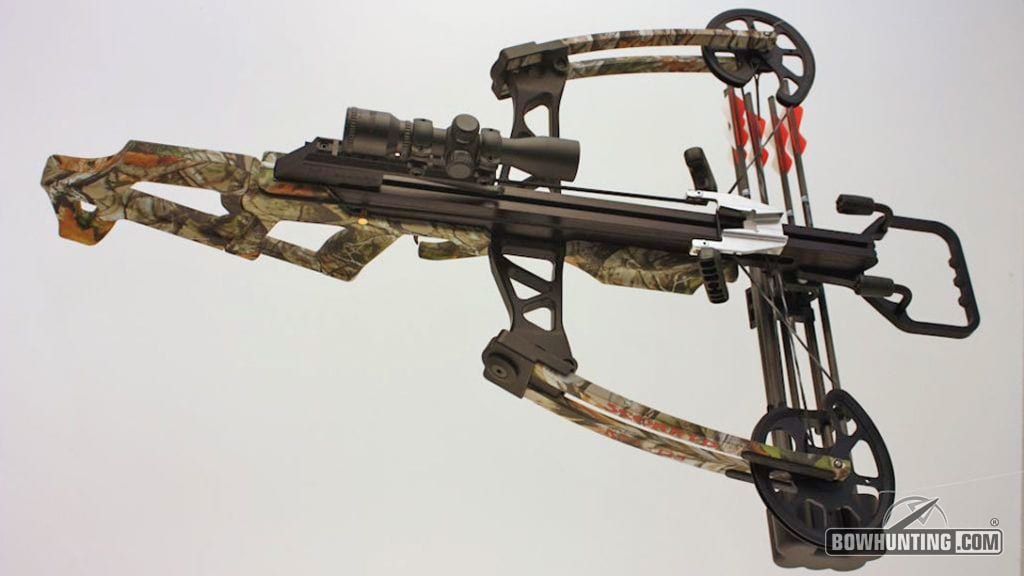
Typical Reverse Draw Crossbow
Crossbow Draw Weights:
The next characteristic that should be considered is the crossbow’s draw weight. Currently draw weights (the number of pounds it takes to draw the string back into the cocked position) range any were from 90 to 260 lbs with the average of most bows being in the 175 lb range.
The primary consideration should be what poundage you are capable of comfortably drawing back. There are several options for cocking devices which are available to assist the archer in lightening their load when it comes to cocking a bow.
Crank cocking devices can be built into the stock or attached and provide a pulley-type system to mechanically draw your bow back eliminating strain on the user. The most popular system is a cocking rope which attaches to the string, is anchored at the backend of the shooting rail and reduces the draw weight by 50% when drawn.
Draw weights are not the final determination of how fast your arrow will be launched from your crossbow. Other factors include features of your bow such as length of power stroke and limb configuration. A 165 lb draw weight can propel an arrow from 300 to over 400 fps depending on which crossbow you are using.
Generally speaking, the greater your draw weight, the more unforgiving your crossbow becomes; thereby magnifying shooter’s errors and increasing wear and tear on the bow’s components such as limbs, strings and servings.
Higher draw weights can also take a toll on the body of the user especially when spending long periods of time on the range where one is cocking and re-cocking their crossbows. Therefore it is important to choose a draw weight that will do the job, but not take a toll on both shooter and crossbow components. It is important to choose a draw weight that will allow the user to cock it easily and often.
Crossbow Arrow Speeds:
Modern crossbows are available with arrow speeds anywhere from 265 to well over 400 fps. The common thinking by the average user is the faster the arrow speed the flatter and farther it can be shot, thereby increasing the distance that big game can be taken.
Regardless of a crossbow’s arrow speed, most crossbow hunters are in agreement that any shot over 40
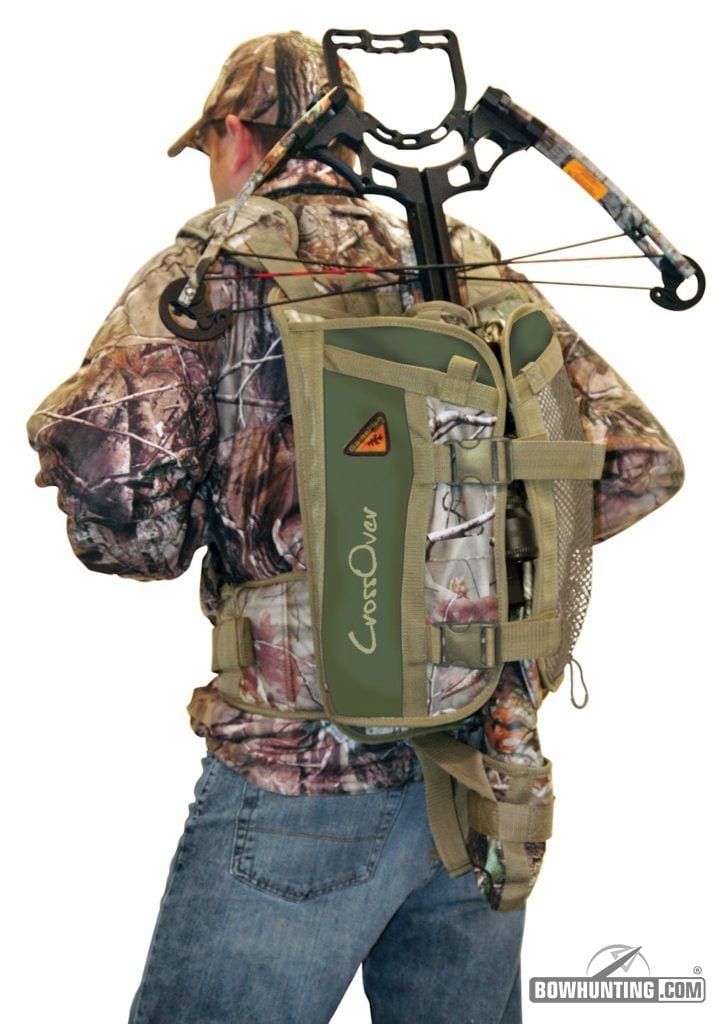
Know your gear and how it will perform when on the hunt.
yards at live game is an unethical one. A crossbow is capable of accurately shooting at longer distances at a still target, but live game is anything but still, especially when hunting whitetail deer, the most common pursuit of crossbow hunters.
Because of the additional noise created by a crossbow when fired, a whitetail can jump the string even at 20 yards when fully alerted. At forty yards, the animal is allowed even more time to change its position creating the possibility of a complete miss or even worse, a wounding or crippling shot.
A crossbow arrow loses its kinetic energy much quicker than one from a vertical bow does because of the shorter power stroke. This means that at longer distances, especially when hitting bone, your arrow is more likely to wound or maim your quarry preventing a good clean, humane kill and quick recovery.
The object of all bowhunting hunting is to get as close to your quarry as possible before taking your shot. If you want to take a hundred yard shot, buy a shotgun or a rifle, which is specifically designed for a long shot. Archery, with any type of bow and arrow, is a close-range sport. The best shot with a bow is a twenty-yard, broadside shot. Taking long shots is not only risky, but it also shows a lack of respect for the animals we hunt. Don’t buy a crossbow with the fastest arrow speed thinking that you will be able to successfully take big game animals at a hundred yards; you will end up being very disappointed. Develop and hone your hunting skills rather than buying a more powerful crossbow because you think it will be a shortcut to success.
Crossbow Accessories:
Along with the explosion in crossbow sales, the accessory market has dramatically increased as well. New crossbow hunters are discovering that once they pick up a crossbow there is a whole line of side items that help to make them more efficient.
Most crossbow manufacturers will recommend the proper size arrow to use with each individual crossbow. This is very important information! If you shoot too light of an arrow, it amounts to dry firing your bow and it may blow up. You may purchase other brand-name arrows, but remember: size and weight is important, do not vary from the manufacturer’s suggested length and weight.
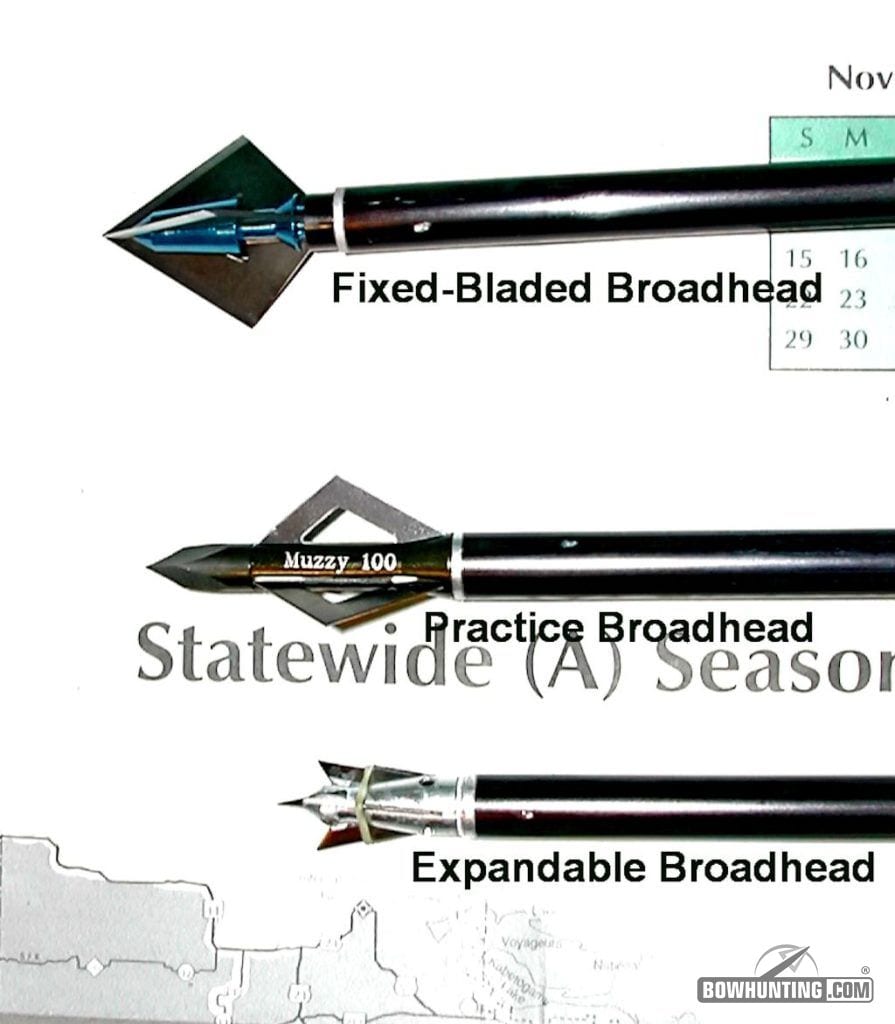
Take the time to test a variety of broadheads designed specifically for crossbows to find what works best for your setup.
Consider using a lighted arrow like Lumenok. The additional cost of the lighted tip will pay for itself over and over in the recovery of arrow that would have been normally lost.
Special broadheads that are made just for crossbows are highly recommended. Crossbow arrows fly better with heavier broadheads to stabilize their flight. Manufacturers are making crossbow broadheads all the way up to 175 grains, with the most recommended weight being 150 grains. Even companies that specialize in broadheads are coming out with heads that are made specifically for crossbows. Whatever you have been shooting may work fine, but shoot plenty of shots with the broadhead to determine that they will fly accurately from a crossbow. Don’t automatically assume that just because the head flew well out of your vertical bow, it will fly fine out of a crossbow.
There is a wide variety of optics available for crossbows. There is no real need for a lot of magnification with a crossbow, but a little can be advantageous. And here again, everyone has their favorite type of optics. A lighted reticle is a distinct advantage especially in early morning and late evening hunting. Check out the options before you purchase your bow to make sure that you get the type of scope you favor.
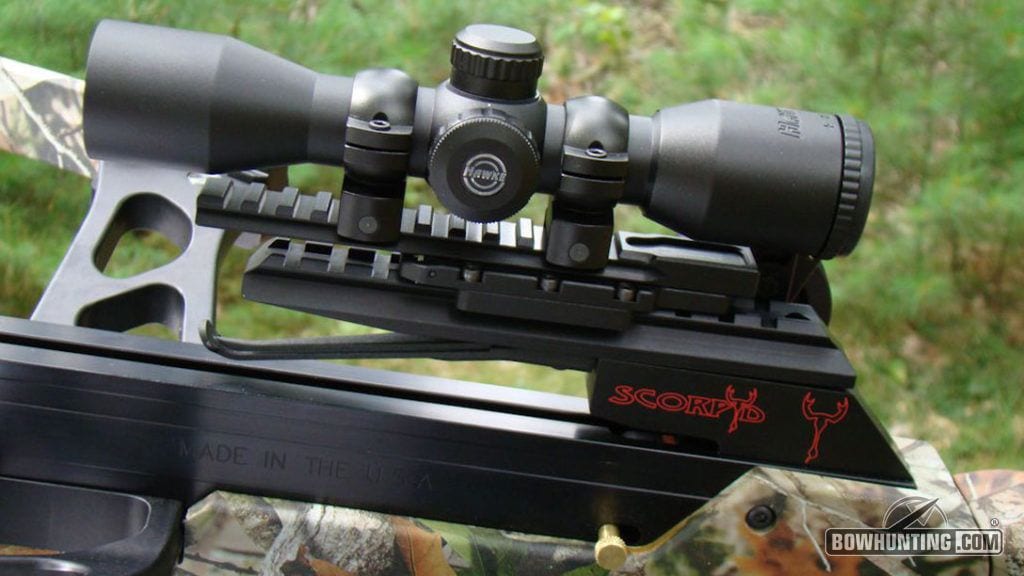
There are many scope options on the market today. Make sure you get one you’re comfortable with.
Crossbows are heavier that a vertical bow so purchasing a robust sling is a very good idea, especially if you are going to be doing a lot of hiking with it. Make sure the sling is well padded and has a non-slip surface to keep it in place on your shoulder. They even manufacturing backpacks that have built in carriers for your crossbow for long hauls and that assist you getting into and out of your stand.
Once you are in your stand, a crossbow hanger to store your bow is a good idea. The crossbow is
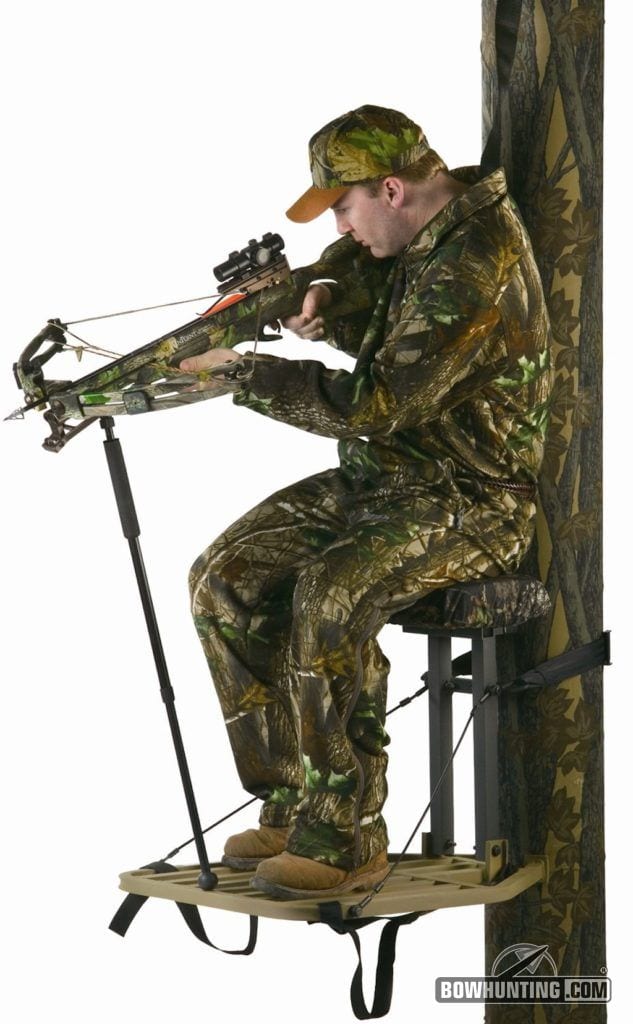
A shooting rest will improve your performance and accuracy.
cumbersome and heavy so having a place to hang it within easy reach is a good idea and provides relief over a long sit on the stand. There are even hangers that keep the bow suspended right in front of your face for instant access when game is spotted. Another acquisition you might like to consider is a shooting rest. There are many styles available and they will serve you well in supporting the extra weight of a crossbow while waiting and it will also improve your shot at the moment of truth. Holding a crossbow to your shoulder for long periods of time can not only be painful, but also impossible. A good, dependable shooting rest will save the day.
As with vertical bowhunting, you will need a good, short-range rangefinder. It is not always practical to range your target when you are juggling a crossbow so upon arriving at the stand, range key landmarks all around your stand and then memorize the distances of each to use as reference points. Arrows can drop quickly from a crossbow and you don’t want to lose your trophy because you misjudged the range by ten yards.
Crossbow Personal Needs:
Most importantly consider your personal needs when you buy a crossbow. Go to an outlet that has plenty of brands and models. Pick up each crossbow and shoot the ones you like the best. Once you find one that fits just right and feels really comfortable in your arms, that will be the very best one for you. It will give you the confidence you need to be successful in the field. Don’t get caught up in the name-game, but select a bow that feels the best to you.
Shooting and hunting with a crossbow is a fun and exciting way to spend time in the outdoors. Crossbows allow the little guys to start hunting earlier, and the older generation to hunt longer. And more time in the deer woods is always a good thing.






